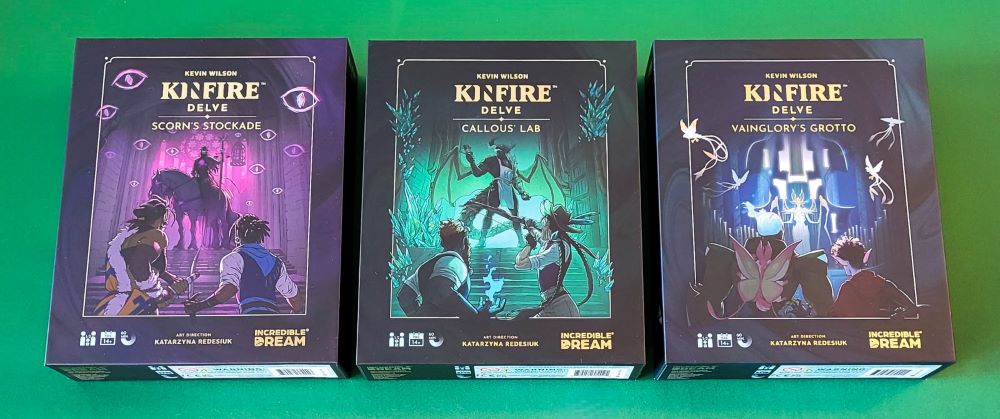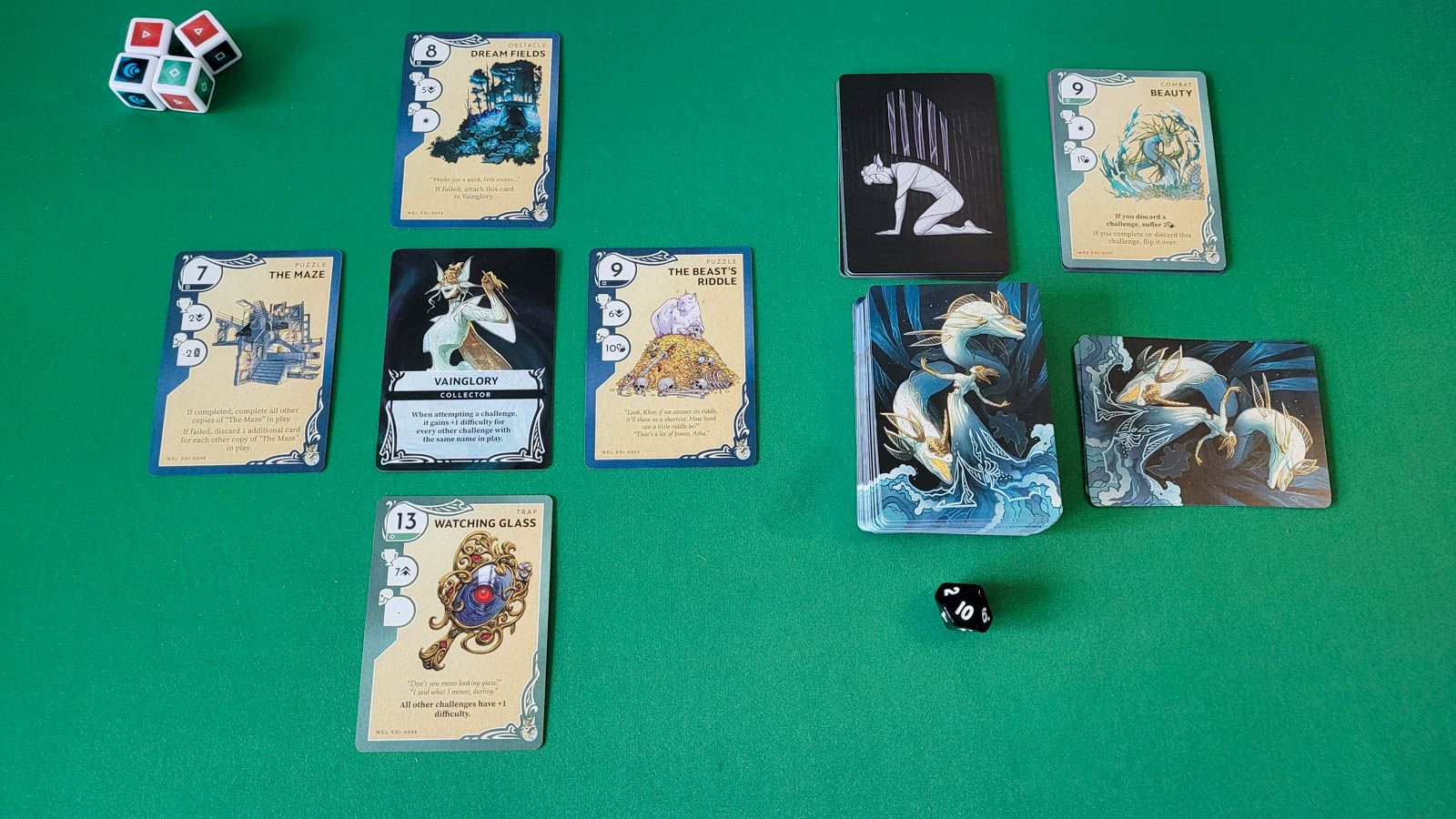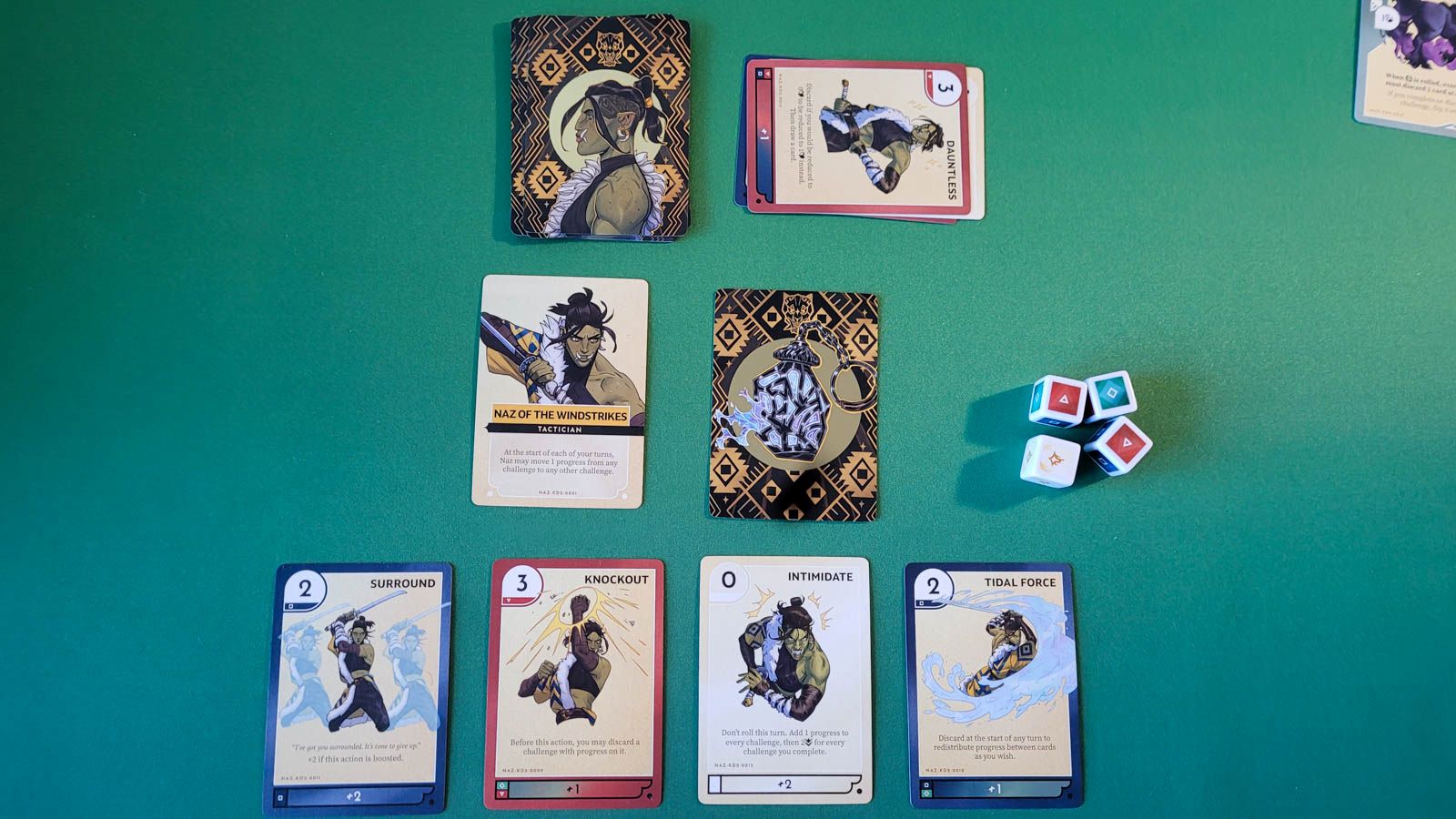Kinfire Delve Review
Year: 2024 | Players: 1-2+ | Min: 45+ | Ages: 14+
This Kinfire Delve review was made after playing all three games two times each. The publisher sent us the three games in exchange for an honest review.
What is Kinfire Delve?
Kinfire Delve is a series of three standalone fantasy card games—Vainglory’s Grotto, Callous’ Lab, and Scorn’s Stockade— in which you use your characters’ skills to take on challenges before facing the Well Master.
These are two-player games on their own, but they go up to four players when you bring characters from one game to another.
All three Kinfire Delve games were designed by Kevin Wilson and published by Incredible Dream Studios.
Rules Overview
In Kinfire Delve, you and your teammate(s) play as Seekers tasked with preventing the Well Master from escaping into the world. You’ll face many challenges and events as you go deeper into the Well, leading to a final confrontation with the Master.
Each player controls a Seeker with a unique deck of skill cards. These cards are used to attempt challenges or support other players.
Turn Structure
- Event/Challenge Selection: On your turn, you select one of the four Well cards surrounding the Master. If it’s an event card, you simply resolve its effects. If it’s a challenge card, you’ll attempt to complete it by adding progress tokens.
- Play a Skill Card: Play a skill card that matches the color of the challenge. The skill card will add progress toward completing the challenge.
- Boost: Other Seekers can assist your challenge attempt by playing boost cards from their hands, adding more progress. Two boosts are allowed per turn.
- Roll Dice: Roll the four dice to potentially add extra progress. Dice that match the color of the challenge give bonus progress.
- Complete or Fail the Challenge: If your total progress meets or exceeds the challenge’s difficulty, you complete the challenge and gain its rewards, then remove the challenge card and draw a new one from the Well deck. If not, the challenge remains in play, and you suffer its penalties.
- End of Turn: Discard any cards you played, then the next player takes their turn.
Key Rules
- Lanterns: Each Seeker has a kinfire lantern that begins the game inactive. Once charged, the lantern can be used like a powerful skill card.
- Health: The Seekers share a health pool that is tracked on a ten-sided die. Health can sometimes be restored through certain actions or rewards.
- Exhaustion: If you run out of skill cards or you want to draw a new hand, you draw an Exhausted card and then draw a new hand of cards. The Exhausted card introduces effects that make the game more difficult.
- Reaching the Master: If you need to draw a card from the Well deck and the deck is empty, you’ll face the Master. Once the Master card is revealed, along with its four gauntlet cards, you must complete its challenge to win the game. The Master can only be fought when it becomes vulnerable to skill colors, revealed by completing the gauntlet cards’ challenges.
Winning and Losing
You’ll win by defeating the Master. You’ll lose if your health drops to zero or certain negative conditions are triggered (like some found on Exhausted cards).
Pros and Cons
Pros
- My favorite thing about Kinfire Delve is how much cooperation there is throughout each game. You have to sacrifice cards to help others via boosts, so you feel like a good teammate when you do it, and you definitely appreciate it when other players boost your cards. There are also Seeker abilities that can help other players. On top of all of that, you have to talk out each turn to get the most out of everyone’s cards, so there really is constant cooperation in this game.
- All six of the Seekers (two per game) have unique skills and playstyles, and they’re all a lot of fun to play. My favorite is Valora Helmsman from Callous’ Lab, but I never felt like one was way stronger than any of the others, which is great.
- The card art, especially on the back of the cards, is ridiculously nice. If I ever update the best board game art page, Kinfire Delve will probably land in the top five.
- The exhaustion mechanic makes hand management more interesting than most other co-op card games. You don’t draw at the end of your turns like in other games, which puts more pressure on you to make good decisions. Plus, those Exhausted cards can make the rest of the game much tougher, so you have to figure out how to play as efficiently as possible. All of that stuff makes this game feel unique.
- I also really like how the lanterns work. There aren’t a lot of ways to activate them, so when you do get access to that awesome skill, you care that much more about finding the perfect time to use it.
- It’s exciting when you have a card that gives you a bonus just by being in your hand. I love it when games include those kinds of cards.
- Once you get used to the Seekers and the iconography, you can move through turns really quickly. You spend a little time deciding which cards to play, but the action resolution is fast and keeps the game moving.
- I like how tough Kinfire Delve is. We won two of our six games, and both wins were nail-biters.
Cons
- The game is fun, but there’s not a ton of replay value if you only have a single set. All of the Seekers are fun to play and the randomness of the Well deck will always keep things interesting, but I could see it becoming a bit too samey after 10 or so games with the same cards. I’m surprised all three sets weren’t combined into a single box from the start.
- I was a little disappointed that the rulebook didn’t include any backstory for the Seekers. It feels like a missed opportunity to add some depth to the characters.
- The dice and progress tokens work just fine, but they feel/look low-quality compared to the other components. They don’t quite match the higher quality of the cards and artwork.
Final Thoughts
Kinfire Delve is an excellent cooperative card game system. It’s about as cooperative as co-op games get, all of the Seekers are unique and fun to play, the Well decks are tricky to navigate, and the art is extremely nice. I have some minor issues with it, but this is one of the best co-op card games I’ve played in years.
I prefer Kinfire Delve as a two-player co-op, but three-player and four-player games work well. You have more skill types to work with and more players to boost your actions, but I just prefer the two-player snappy flow a bit more.
If you like co-op fantasy card games, chances are you’re going to have a great time playing Kinfire Delve. Callous’ Lab is my favorite set because it has my favorite character, but you really can’t go wrong with any of the three sets.
These three boxes are definitely staying on my shelf, and I’m really hoping Incredible Dream Studios releases more Kinfire Delve content.
Kinfire Delve Links
BGG | Miniature Market | Cardhaus
Thanks for taking the time to read our Kinfire Delve review!
Be sure to also take a look at our Best Co-op Board Games list and the other board game rankings.
Subscribe to our newsletter if you want more co-op board game content sent right to your inbox!
[Sassy_Social_Share title=”Share this page”]




